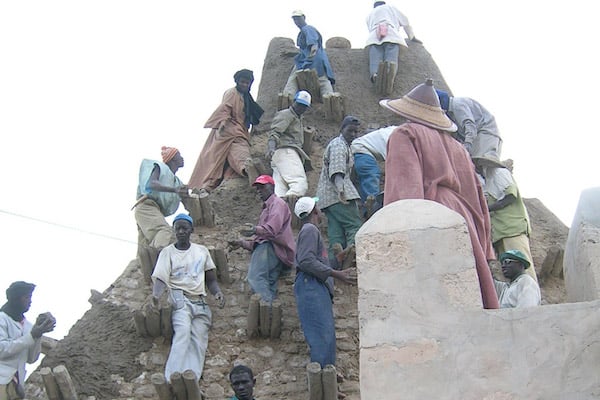Art World
Local Timbuktu Workers Rebuild Shrines Flattened by Al-Qaeda
UNESCO and the European Union are behind the conservation project.

Photo via: UN News Center
UNESCO and the European Union are behind the conservation project.

Lorena Muñoz-Alonso

Fourteen ancient mausoleums, destroyed by an Al-Qaeda-related attack in Timbuktu, are being restored by a team of local workers, AFP reports.
The shrines, erected in the 15th and 16th centuries to honor Muslim saints, were flattened in 2012 during a jihadist takeover of the city 600 miles northeast of Mali’s capital Bamako.
In 2013, the extremists were expelled from the city during a French-led military campaign. In 2014, UNESCO signed an agreement with the European Union to rebuild 14 of the 16 destroyed structures, in collaboration with the Malian government. (See ISIS Militants Storm Museum and Smash 3,000-Year-Old Assyrian Sculptures on Video.)
The project is expected to last up to four years, and has a total budget of $11 million. Only $3 million have been raised so far, however, thanks to contributions from the World Bank, the European Union, Switzerland, and the US Agency for International Development.
Abderrahmane Ben Essayouti, imam of Timbuktu’s Grand Mosque, has made an appeal for “the world to support the project that would bring Timbuktu back to life,” according to AFP.
An Important Step Towards National Reconciliation
Local workers have been employed to carry out the task, a decision that has created 140 jobs in the area. Workers are using traditional methods and local materials, including alhor stone, rice stalks, and banco—a mixture of clay and straw.
“What’s nice is that UNESCO did not look for masons elsewhere,” one of the local workers at the site told AFP. “[…] We know what must be done to save our culture,” he said.
The reconstruction endeavor has not only made a positive impact on the labor economy of the area. For UNESCO’s Mali representative, Lazare Eloundou Assomo, the project might also be an important step towards a “national reconciliation” between different ethnic groups that are based in the country. (See Did ISIS Smash Fake Sculptures in Mosul.)
The first shrines to be tackled were devoted to three saints hailing from different regions and ethnicities: the town of Djenné, the Kunta tribe, and the neighboring country of Algeria.
“It’s the Mali rainbow: with a black saint, a saint who is a native of Timbuktu, and another from the Maghreb,” Assomo explained.
The rehabilitation project also encompasses the conservation of Timbuktu’s famous collection of ancient manuscripts, which were also subjected to jihadist violence.
Up to 4,000 manuscripts were lost, stolen, or burned during the 2012 Islamic raids, while 10,000 were found in critical conditions.
370,000 documents were saved, however, and taken to Bamako to be protected from jihadists. Malian archivists are currently classifying and digitising them for posterity.
A group of 16 priceless manuscripts from Timbuktu were exhibited at the BOZAR art center in Brussels last winter (see Timbuktu Manuscripts Rescued from Jihadist Destruction Go on View).